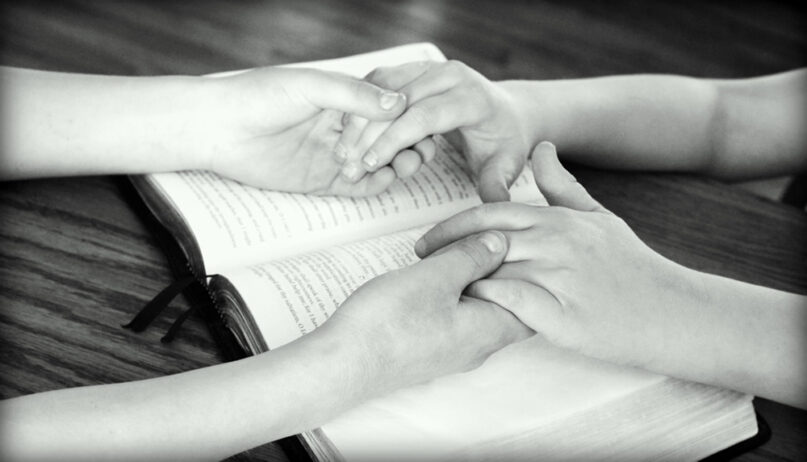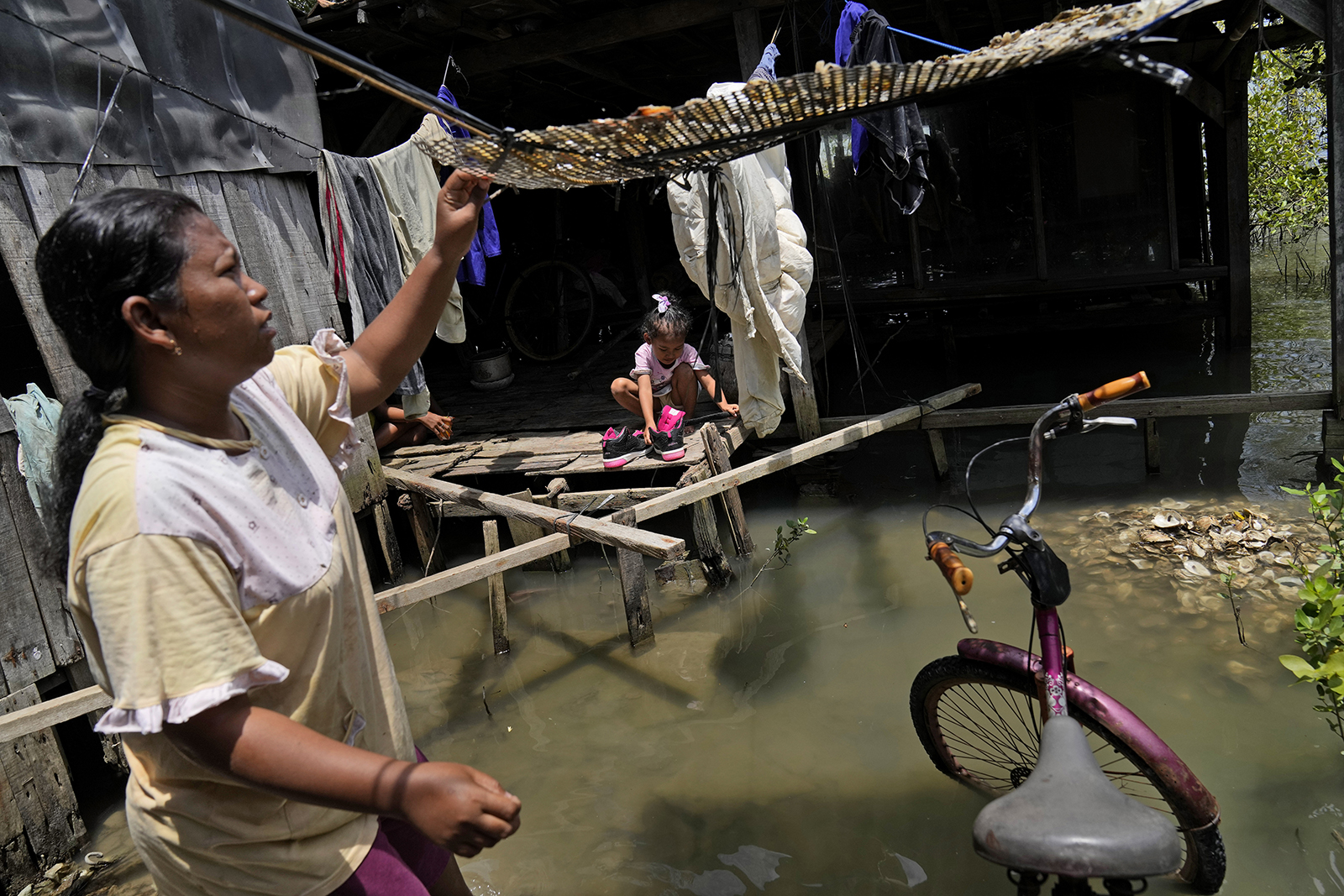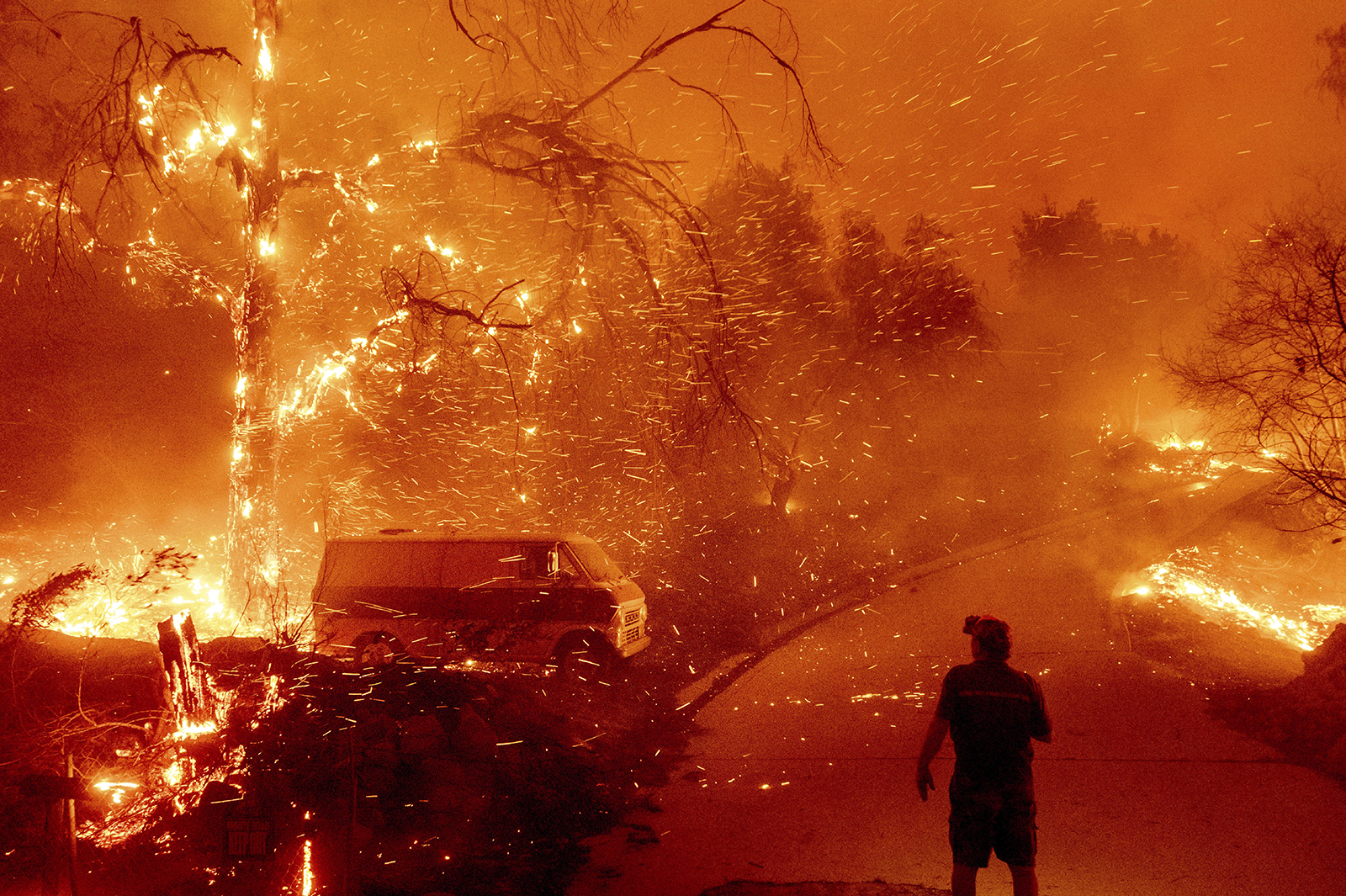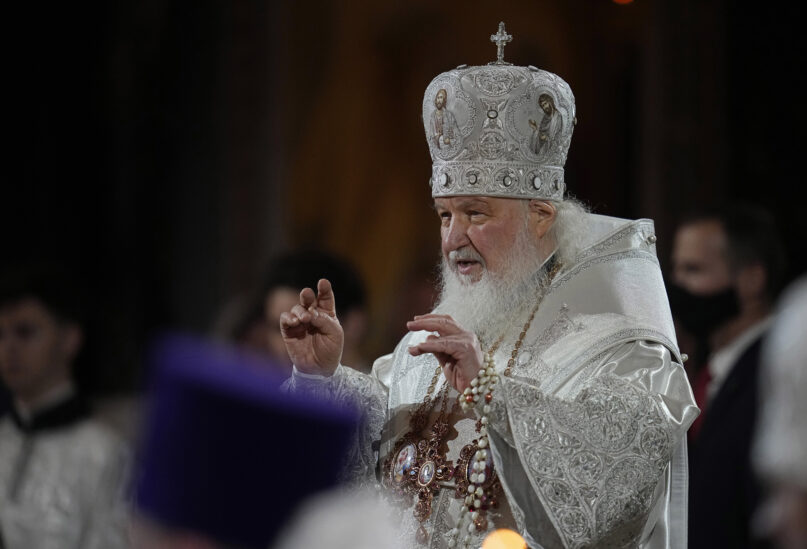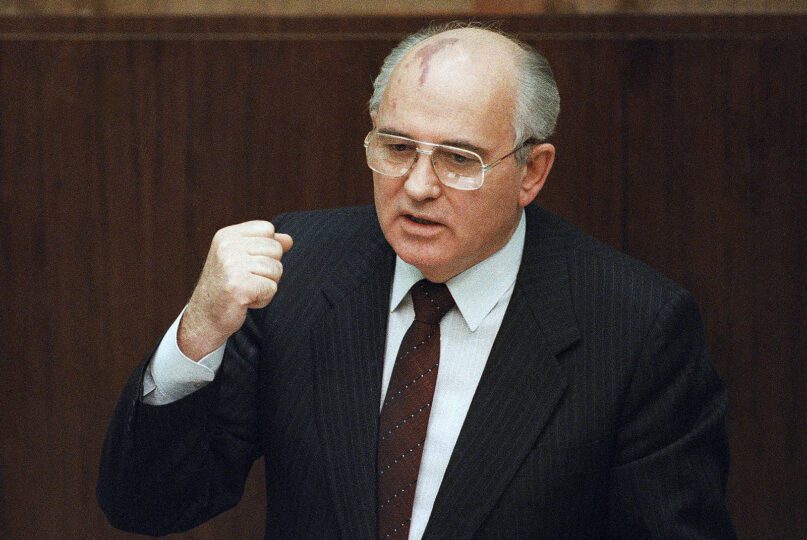(RNS) — After a sometimes tense week that included passionate exchanges, the 11th assembly of the World Council of Churches approved a statement on Thursday (Sept. 8) regarding Russia’s invasion of Ukraine that denounces the war but does not single out the leader of the Russian Orthodox Church, Patriarch Kirill, who has been widely criticized for supporting the invasion.
The statement condemned “this illegal and unjustifiable war,” and specifically rejected “any misuse of religious language and authority to justify armed aggression and hatred,” while calling on all parties to refrain from military action around the Zaporizhzhia nuclear power plant.
But the document produced by the assembly, meeting in Karlsruhe, Germany, is unlikely to satisfy critics who in recent months have called for the group’s leadership to strip the Russian church of its membership in the ecumenical body.
Moscow’s patriarch has already been sanctioned by the United Kingdom because of his rhetoric. The European Union also discussed similar sanctions, but they were reportedly abandoned after Viktor Orbán, the prime minister of Hungary and an ally of Russian President Vladimir Putin, intervened.
Kirill has spent years outlining what is widely seen as the spiritual foundation for the invasion, inserting a religious justification for reclaiming Russia’s sphere of influence in Ukraine and elsewhere with references to “Holy Rus” or “Russian world.” Earlier this year, hundreds of Orthodox theologians and scholars declared the concept a heresy.

RELATED: World Council of Churches faces calls to expel Russian Orthodox Church
At an opening press conference on Aug. 31, outgoing WCC General Secretary Ioan Sauca, a Romanian Orthodox priest, announced the group’s central committee had rejected efforts by critics to expel the Russian church earlier this year.
“The WCC is a free space for dialogue, and we come together not because we agree with one another but because we disagree,” said Sauca, saying the proposal to expel the Russians was unanimously defeated.
Sauca said he and others had visited Ukraine this year and that observer representatives of Ukraine would be present for the assembly. But in the days that followed, any hope of brokering formal dialogue between the Ukrainians and ROC members during the proceedings appeared to dissipate.
German President Frank-Walter Steinmeier addressed the assembly Aug. 31, singling out the Russians in his remarks. He noted that while a number of Russian Orthodox priests have spoken out against the war and faced legal action for it, church leaders have actively supported the Russian government’s military actions.
“The heads of the Russian Orthodox Church are currently leading their members and their entire church down a dangerous and indeed blasphemous path that goes against all that they believe,” said Steinmeier.
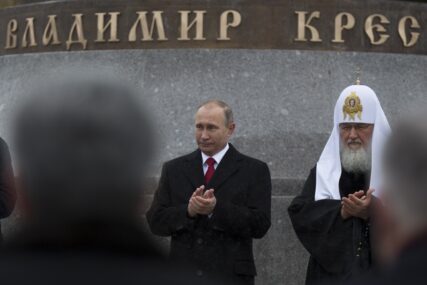
FILE – Russian President Vladimir Putin, center, and Russian Orthodox Patriarch Kirill applaud during the unveiling ceremony of a monument to Vladimir the Great on the National Unity Day outside the Kremlin in Moscow, Russia, Friday, Nov. 4, 2016. President Vladimir Putin has led ceremonies launching a large statue outside the Kremlin to a 10th-century prince of Kiev who is credited with making Orthodox Christianity the official faith of Russia, Ukraine and Belarus. (AP Photo/Alexander Zemlianichenko)
“We have to speak out, also here in this room, in this assembly, against this propaganda targeting the freedom and rights of the citizens of another country, this nationalism, which arbitrarily claims that a dictatorship’s imperial dreams of hegemony are God’s will,” the president said.
Acknowledging Russian Orthodox delegates in the room, Steinmeier asked that other assembly attendees “not to spare them the truth about this brutal war and the criticism of the role of their church leaders.”
In his own address on Sept. 2, Archbishop Yevstratiy of Chernihiv and Nizhyn of the independent Orthodox Church of Ukraine accused Russian soldiers of atrocities. Two weeks into the war, he said, troops opened fire on unarmed civilians manning a checkpoint just outside of the village of Yasnohorodka, killing a local parish priest who had raised his cross as he tried to protect civilians.

“Today, Ukrainians are the ones attacked by robbers,” Yevstratiy said in his condemnation, invoking the biblical parable of the Good Samaritan. “Do not pass by our suffering and our pain, as the priest and the Levite of the parable!”
Yevstratiy thanked WCC members for speaking out against Kirill’s support for the war and recommended that the Ukrainian Orthodox Church, which declared itself independent of Moscow in 2018, be granted full WCC membership.
RELATED: Will the World Council of Churches expel Kirill? We talk with Bishop Mary Ann Swenson
Tensions flared again days later when the proposed statement on the invasion of Ukraine was introduced to the assembly. Roman Sigov, who identified himself as part of the Ukrainian Orthodox Church observer delegation, stepped to the microphone, urging WCC leaders to respond to his group’s submitted comments. (Leaders ultimately accommodated only two minor wording changes in the final document.)
“I cannot express how much it hurts to hear a statement which treats the victim and the aggressor in the same way,” Sigov said. He also accused Russian prelates present of supporting the war and, in one case, sharing videos on social media mocking Ukrainian prisoners.
“Let us hear the voice of Ukrainians when talking about the war in Ukraine,” he said, noting that independent Ukrainian churchmen, unlike Russian Orthodox leaders, lacked official representation at the assembly.
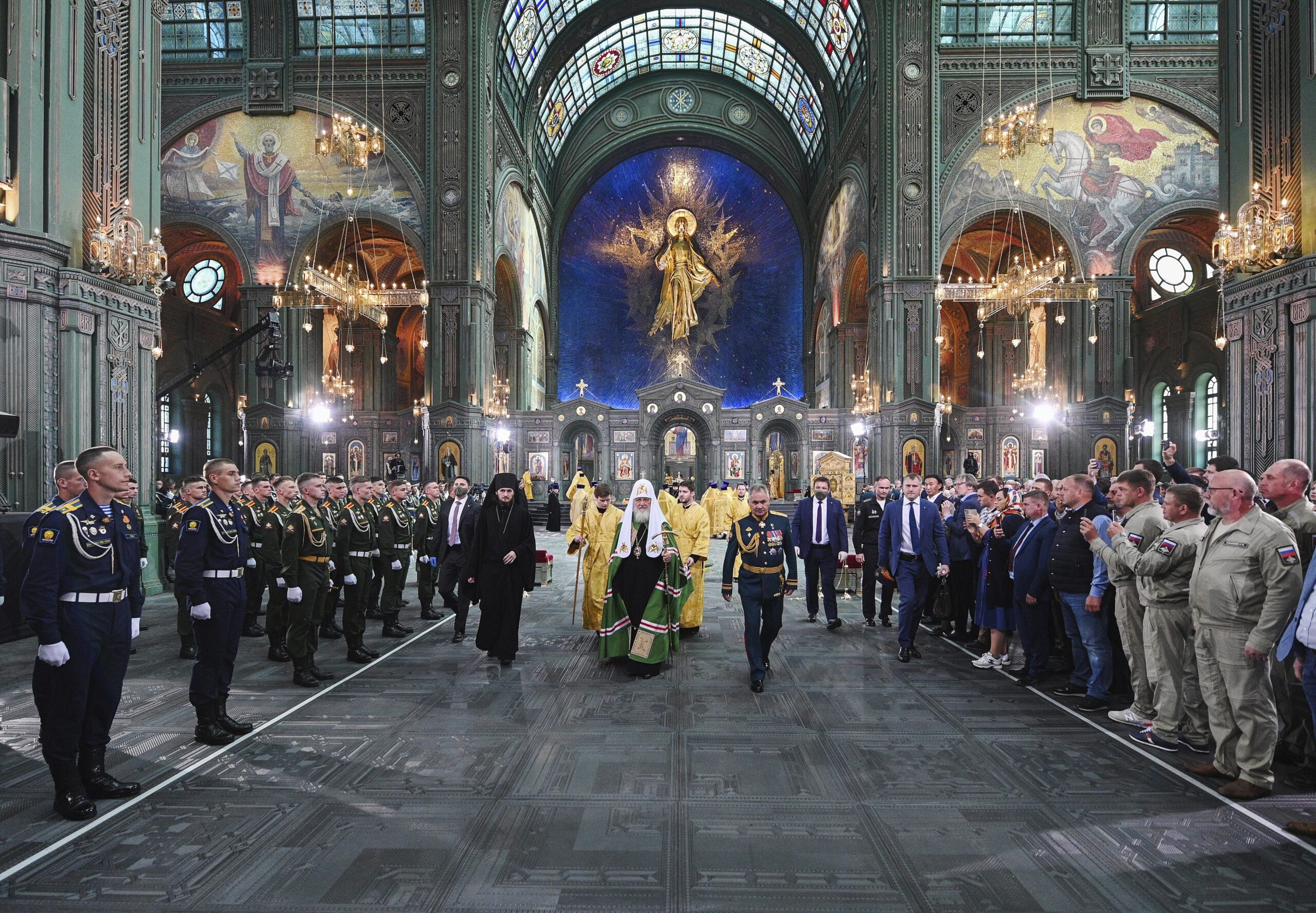
Russian Orthodox Church Patriarch Kirill, center, and Russian Defense Minister Sergei Shoigu, right, at the consecration of the Cathedral of Russian Armed Forces outside Moscow, June 14, 2020. (Oleg Varov, Russian Orthodox Church Press Service via AP)
The Russian Orthodox were also critical of the statement. One Russian delegate, Archimandrite Philaret Bulekov, dismissed it as part of an “information war” and derisively likened it to anti-war statements from McDonald’s and Starbucks, saying it would occupy “the same level of importance.”
He called the German president’s speech “pathetic” and alleged that Steinmeier bore “personal responsibility” for the Ukraine invasion.

After Bulekov finished, a youth observer representing the Orthodox Church of Ukraine, Oleksandra Kovalenko, called on members of the Russian delegation to raise their blue voting cards if they opposed the Russian invasion of Ukraine. According to one attendee, no blue cards were raised.
“It is very sad that you compared the blood of Ukrainian people to Starbucks and McDonald’s,” said Kovalenko to applause from many in the chamber.
Pressed by journalists at a closing press conference, members of the WCC central committee acknowledged Ukrainian and Russian Orthodox delegations did not formally meet during the assembly. Metropolitan Nifon of Târgoviște, a Romanian Orthodox priest who is vice moderator of the WCC committee, said members of the two sides may have talked informally and “exchanged some views.” Formal dialogue, he said, remains a goal.
“For people to come to the table, it takes a lot of footwork in the background,” said Agnes Abuom, moderator of the WCC Central Committee representing the Anglican Church of Kenya. “That needs to continue to happen in order that there will be trust, the willingness to come to the table and dialogue.”
Mary Ann Swenson, a United Methodist Bishop from the U.S. and a vice moderator of the central committee, expressed hope for such talks. “We really did do some breaking down of walls in a lot of ways,” she said.
As important at this stage, she said, was making sure others heard the stories of those ravaged by the ongoing war. “I would also say that a significant thing was that other people in all of the other parts of the world got a deeper and better understanding of what people are really living with in that region, to hear some of the struggles from all of the people in that region. That will make a difference in the future.”
(RNS) — The legacy of Mikhail Gorbachev, so celebrated in the West, evokes deep ambivalence among Russians and Russian Orthodox believers. After 70 years of persecution and marginalization under the Soviet regime, the Orthodox Church took advantage of Gorbachev’s invitation to reenter public life.
But the last Soviet leader also failed the church in many Orthodox eyes. He reduced religion to a private, individual matter; tragically, he could not see Russian Orthodoxy as the politically privileged religion of both Russia and its Eastern Slavic neighbors. The position that he rejected has now helped Russians justify the invasion of Ukraine.
The Russian Orthodox Church was once the church of Russia and Ukraine. Under Gorbachev, Ukrainian Greek Catholics and adherents of an autocephalous — independent — Ukrainian Orthodox Church came out of the underground, eventually demanding legal status and the return of church properties the Communists had confiscated and given to the Russian church. Gorbachev made the mistake, his Orthodox critics charge, of applying glasnost and perestroika to religious affairs, rather than securing the unity of the nation and its historic church.
RELATED: How Putin’s invasion became a holy war for Russia

Gorbachev did not immediately reverse the government’s anti-religious policies when he came to power in March 1985. After the 1917 October Revolution, the new Soviet rulers razed churches or turned them into factories, gymnasiums, apartment buildings and warehouses. Church bells were not permitted to ring, nor could the martyrs of the gulag be canonized. Candidates for the priesthood had to be vetted by state religious affairs officials and security forces. Most monasteries were closed.
State authorities restricted religious activities to the remaining church buildings — educational endeavors or social ministries were forbidden. Attendance at religious services would often result in difficulties at work or school. At Easter, the police surrounded churches and demanded to see people’s passports. Religion increasingly became a matter best left to the babushki.
The church’s fortunes rose and fell in the following decades. Stalin relaxed anti-religious measures in exchange for the church’s support in the war against the Nazis, but Nikita Khrushchev, Stalin’s successor, pressed an aggressive campaign for atheistic indoctrination. Then, in 1983, in anticipation of Russian Orthodoxy’s celebration of its millennium in 1988, the government returned Moscow’s historic Danilov Monastery to the church.
But by the beginning of the Gorbachev era, fewer than 7,000 Orthodox parishes were in operation, compared with 50,000 in 1917. Only a couple of dozen of small monastic communities persisted, whereas there had once been a thousand.
Although himself a confirmed atheist, Gorbachev believed that Orthodox Christianity could counter the widespread demoralization and atomization of society that had occurred under communism and that Gorbachev was fighting with his perestroika and glasnost policies.
On April 29, 1988, an unprecedented meeting of church and state took place at the Kremlin: Gorbachev spoke for 90 minutes with Patriarch Pimen, acknowledged the Soviet state’s historic “mistakes” toward the church and promised a new era of religious freedom. The preceding months had already seen dramatic changes. Two major monastery complexes had been returned to the church, and the Easter liturgy had been broadcast for the first time on Soviet television.
Now, the rate of change accelerated. In June, Gorbachev’s wife, Raisa, and leading government officials attended the church’s jubilant millennial celebrations. By the end of the year, the church had established 800 new parishes, constructed dozens of church buildings and recovered the church’s most ancient monastic complex, the Monastery of the Caves in Kyiv.
It was a heady time. Orthodox priests began appearing regularly on television. The charismatic Orthodox priest Alexander Men attracted crowds of 15,000 in stadiums for his lectures on the Bible and religious life. Parishes organized Sunday schools and educational institutes. As the state-controlled social security net became increasingly frayed, Orthodox lay brotherhoods and sisterhoods stepped into the breach. Hospitals, orphanages and alcohol and drug rehabilitation centers, once off-limits to believers, flung open their doors, thankful for the church’s charitable work.
Over the objections of many local officials, church leaders now felt free to appeal to Gorbachev to defend their rights. By 1991, the church had more than 10,000 parishes and close to a hundred monasteries. Shortly before the demise of the Soviet Union in December of that year (and the end of his presidency), Gorbachev succeeded in passing a law of religious freedom and conscience that resembled the American model of separating church and state.
One church leader exclaimed: “The church is completely free for the first time in its history. The question is whether we will use this freedom.”
Gorbachev regarded the new law as one of his crowning achievements. The problem for many Orthodox believers was that the church now had competition. Dozens of “sectarian” groups emerged, including Jehovah’s Witnesses and Muslim “extremists.” Western evangelical missionaries poured into the country, as though Orthodoxy had never been truly Christian. In Ukraine, religious tensions intensified between the “Moscow church” and nationalistic Orthodox believers.
This loss of ecclesiastical empire came as inflation soared, the gross national product crashed, the Yeltsin government gave away state enterprises to oligarchs, and corruption became a way of life. A counterreaction soon set in, in political and religious affairs.
But even as freedom of religion and conscience became more restricted, the church won a privileged place for itself. With Vladimir Putin’s support, the church has grown to 39,000 parishes and 800 monasteries. It claims the affiliation of 70% or more of Russians. Many of them now associate Gorbachev with the efforts of the West to impose its “moral decadence” on the East. These are the Russians who welcome Putin’s “special military operation” to preserve Russia’s cultural and religious unity with Ukraine, where the fate of 12,000 of those parishes hangs in the balance.
After his death on Aug. 30, Russian Jewish, Islamic and evangelical Christian leaders commemorated Gorbachev enthusiastically for having given their adherents freedom to emigrate, undertake pilgrimages and manage their own affairs. Conservative Orthodox commentators had only scorn: “No other leader in Russia’s thousand years voluntarily gave up half of the country,” said one. Another asserted that Gorbachev was “weak and insignificant not only by historical but also by human standards.”
RELATED: How the war between Russia and Ukraine is roiling the faith tradition they share
The silence of Patriarch Kirill — who has justified the Ukraine invasion on Russian political and ecclesiastical grounds — has been telling. He has issued no statement, offered no condolences. A year ago, he congratulated Gorbachev on his 90th birthday and acknowledged, even if just matter-of-factly, Gorbachev’s efforts “to improve the situation of believers.” Now, the war has apparently made even ambivalence impossible.
Nevertheless, what happens in Ukraine will determine not only Gorbachev’s legacy in Russia but also the future of its church. Thanks to the atheist Mikhail Gorbachev, Orthodox art, architecture, music, ministry, spiritual life and social service could flourish again. Today, a Western observer can only hope that Kirill and his flock will not betray the remarkable freedom for which Gorbachev fought.
(John P. Burgess is James Henry Snowden Professor of Systematic Theology at Pittsburgh Theological Seminary and the author of “Holy Rus’: The Rebirth of Orthodoxy in the New Russia.” The views expressed in this commentary do not necessarily reflect those of Religion News Service.)
